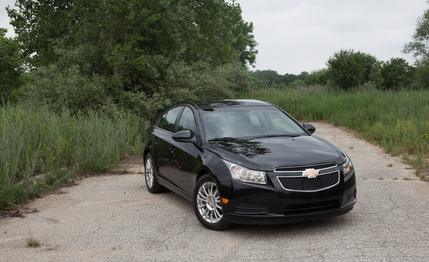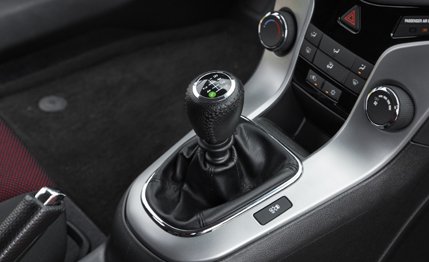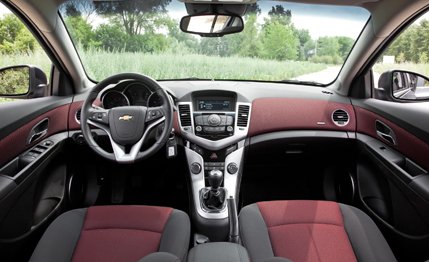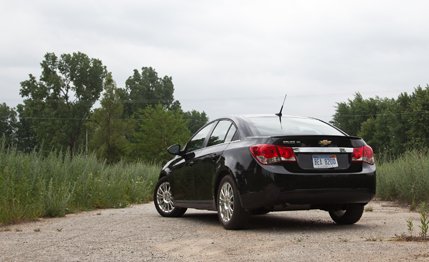 Short Take Road Test
Short Take Road Test

With summer here and gas prices some four to five times the mercury reading, it’s all most drivers can do to stay cool at and away from the pump. Mileage ratings are soaring past horsepower figures in mainstream headlines, and the fuel-economy wars are in full swing. (Paradoxically, so are the horsepower wars. But we digress.) The ongoing influx of hybrids shows no sign of slowing, but costly batteries and electric motors aren’t friendly to all budgets (not to mention curb weights), so automakers are also duking it out with conventional powertrains. One of the hottest battles right now is being waged within the C-segment ring, where cars like this Chevrolet Cruze Eco are topping the 40-mpg-highway mark.
Eco Optimization
Like many economy-optimizing trim packages, the Eco uses low-rolling-resistance tires (Goodyear Assurance) and lighter wheels to help meet its goals. Unlike most of its competitors, though, the Eco has a higher (mileage) calling from the moment it starts down the assembly line. With weight saving a priority, it is constructed differently than the regular Cruze, using slightly shorter welds and thinner sheetmetal in specific areas. The lighter Goodyears and the stylish 17-inch wheels combine for a saving of more than 21 pounds compared with the 16-inch combo on the Cruze 1LT. Factor in a fuel tank that is smaller by three gallons and the lack of a spare tire on manual-equipped cars, and the Eco weighs in at 3018 pounds, between 125 and 188 fewer pounds than other Cruzes we’ve tested.


Although a commendable and essential effort for achieving better fuel mileage, the Eco’s diet isn’t the only difference between it and a regular Cruze. Benefiting from the hundreds of hours its even-thriftier platformmate, the Volt, spent in the wind tunnel, the Cruze Eco is fitted with the latest aerodynamic gewgaws. It has a movable shutter in the lower grille that closes at high speeds, underbody panels behind the lower front air dam, and a rear spoiler. And it sits 0.4 inch closer to the ground. Overall, the Eco’s coefficient of drag is 10 percent less than the standard Cruze’s, helping manual-equipped models achieve 28/42-mpg ratings from the EPA.
Penalty Box No More
Unlike fuel-economy specials of yesteryear, the new crop of misers—like the Hyundai Elantra and Ford Focus SFE—doesn’t require you to serve a penalty for not paying at the pump. Instead of forcing buyers into the most basic, stripped-out model to obtain those extra mpg, the Cruze Eco is a normal conveyance with all the customary amenities of a modern small car.

In fact, if you’re in the market for a Cruze, we’d strongly suggest you consider the Eco. For starters, it’s a fine-looking ride, with the aforementioned lowered stance and showy 17-inch wheels. It looks more sporty than frugal, and we’d even spring for the $195 Black Granite Metallic paint of our test car to add a dash of elegance. Its interior, like those in costlier Cruze trims, is quiet and stylish, with excellent fit and finish. Some of the interior plastics could stand to be a grade or two higher, but the fabric trim panels on the dash are a first-rate focal distraction. With its base price of just $19,175, and the $525 Connectivity package—Bluetooth, a USB port, steering-wheel-mounted audio controls, and a leather steering wheel and shift knob— it’s hard to justify a more premium trim. (Fitted to our 2011 test car, the Connectivity package will be standard equipment on 2012 cars.)
A Closet Enthusiast?
Aiding the Eco’s case is the fact that it essentially ties the quickest Cruze we’ve tested. Chevy acknowledges the fact that the manual’s first- and second-gear ratios are “aggressive,” which helps this miserly compact hit 60 mph in eight seconds flat. The quarter-mile is gone in 16.3 at 86 mph. Previously, our quickest Cruze was an automatic LT RS, which also hit 60 mph in 8 seconds but was a tenth and 1 mph behind in the quarter-mile. And although this car’s slipperier Goodyear rubber howls loudly at low cornering speeds and draws angry stares in the Whole Foods parking lot (maybe that was because we weren’t in a hybrid), the Eco managed a respectable 0.81 g on the skidpad. Braking would have been average a few years ago, but now it’s at the back of the pack. The soft pedal gets worse with repeated stops, with the car needing 184 feet to stop from 70 mph.

Around town, the Cruze is quiet and comfortable, although rough roads elicit the occasional thunderous whack from the suspension. The steering rack is playfully tight but isn’t much into talking back. Those buyers wanting to eke the most from every atom of fuel will appreciate the coaching of the green upshift light, which tries to keep revs between 1500 and 2000. By 35 mph, it wants the car to be in fifth or sixth, the latter of which is a very tall, Eco-specific cruising ratio that offers almost zero power for acceleration. We, of course, drove the Eco like we’d stolen it and still managed 29 mpg overall in 600 miles of driving.
The compact-car class is rich with great choices. Although the 2012 Ford Focus is the current champ, the value offered by the Cruze Eco is at least a good way to beat the heat at the pump.